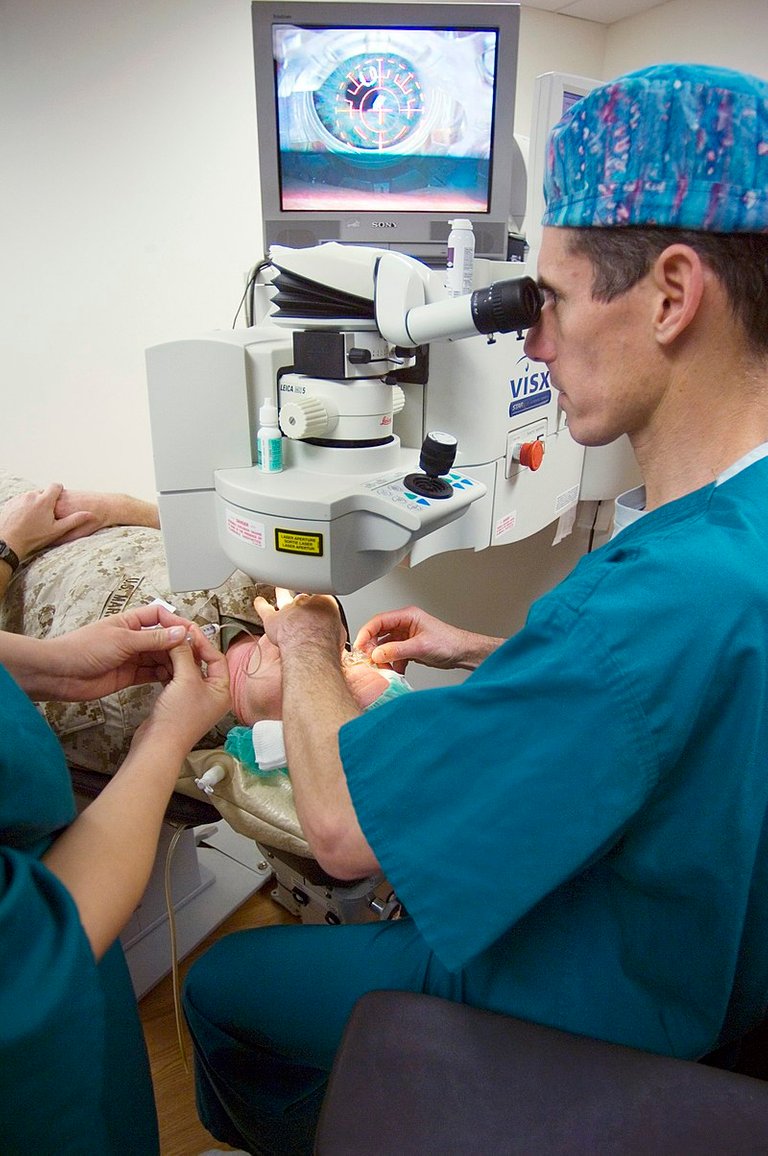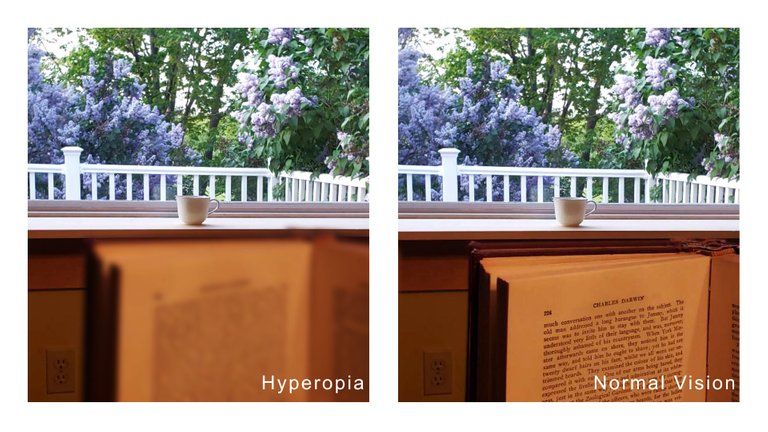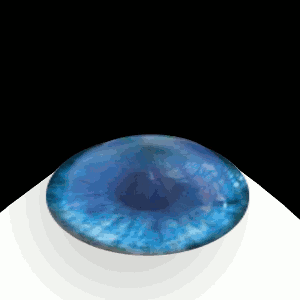Using Laser to Cure eyesight | LASIK surgery
Hey there! Welcome to my new article
Tired of wearing glasses and contact lenses? Some of my friends are. I have seen them getting frustrated over this. I guess everyone who has been wearing glasses for years might have considered getting this surgery. Although I am not an ophthalmologist, my relatives and friends do ask me a lot about this procedure. Anyone, who is considering having this surgery, might be concerned about a few things like, its safety, procedure, complications, etc. In this article, I will cover every aspect of this Surgery.

Image by 070501-N-5319A-007
, Wikimedia, Public domain
Okay, let's start by explaining what this surgery actually means. LASIK stands for "Laser-assisted in-situ Keratomileusis". In-situ means when something is done at the site. In this case, the procedure is performed on the eye itself, hence the term "in-situ". "Keratomileusis" comes from a Greek word that literally means carving or reshaping the cornea. As I said in my previous article, you guys must be familiar with basic eye parts like cornea, lens, iris, and retina. The cornea, lens, and iris work together to form an image on the retina. If the shape of these is altered then the image formation also changes. For example, In shortsightedness or myopia, the light focuses before they reach the retina, due to the higher curvature of the cornea or lens and in longsightedness or hypermetropia, the light focuses behind the retina, due to lower curvature of the lens or cornea.
Therefore, if the curvature or shape of the cornea is somehow manipulated to focus the incoming light exactly on the retina, then this can obviously cure the eyesight and this is what LASIK surgery is all about.
History of LASIK
Lasik surgery is inspired from a surgery that was done in the early 1950s by Jose I. Barraquer (Father of refractive surgery) to correct the refractive error. This surgery was not for the faint-hearted. He actually, sliced of the anterior part of the cornea and froze it by dipping into the liquid nitrogen. Then, he reshaped the frozen cornea very precisely to focus the light exactly on the cornea. Finally, he sawed the sliced cornea back to the eyeball.
Imagine a doctor explaining about the procedure before surgery and he goes "I am going to cut your eyeball, dip it into the liquid nitrogen and put it back". As creepy as it sounds, this procedure actually worked. He proved that reshaping the cornea can actually cure the eyesight.
This technique became the basis of modern Lasik surgery where actual lasers are used to reshape the cornea. Now, modern LASIK surgery is far more non-invasive and advanced. The whole procedure takes only a maximum of 10 minutes for one eye.
Different Refractive Errors
I talked about this briefly above. When the shape of the eye does not let the light bend or focus correctly, that results in blurred images. This is known as refractive error. we suffer from mostly four types of refractive errors.
- Myopia (Shortsightedness)
- Hypermetropia (Longsightedness)
- Presbyopia
- Astigmatism
Myopia: When the person can see near objects clearly and distant objects are blurred, this condition is called Myopia or Shortsightedness. This happens because the curvature of the cornea is higher than normal, which focuses the light before hitting the retina. As you can see in the image.
Hypermetropia: When the person can see far objects clearly but near objects are blurred, this condition is called hypermetropia or Longsightedness. The curvature of the cornea is lower than normal which focuses the light behind the retina. As you can see in the following image.
Presbyopia: This is the same hypermetropia or longsightedness but due to old age. After approx 45 years, the lens becomes more rigid and the eye loses the ability to focus light coming from close range. There can be myopia also at the same time.
Astigmatism: All the other refractive errors I talked about have the symmetric curvature can focus the light on the same plane. But in Astigmatism, the curvature of the cornea is not symmetric, and the incoming light is not focused on the same plane. Therefore, the person sees the object being distorted.
The Actual Procedure
When you get into the room, the surgeon discusses the procedure and makes you calm. The procedure begins by lying down on the operating bed. The surgeon applies some anesthetic drops to numb your eye. Then, your head is correctly positioned under the laser. This is when the actual surgery starts.
This consists of two main steps
- Making a corneal flap
- Reshaping the cornea with a laser
Making a corneal flap: The cornea is also known as the window of the eye. This consists of a total of 5 layers. Epithelium being the top-most or the surface layer. Beneath that lies the stromal layer which is also the thickest one. Successful surgery requires to reshape the stromal layer of the cornea. Therefore, a surgeon must have access to this layer.
Making a flap of the epithelial layer can help in accessing the stromal layer. The flap is made by making a precise incision in a circular strip on the outer layer. One segment of the cornea is left, which acts as a hinge for the flap. This exposes the middle stromal layer. Before 2000 microkeratome, a small surgical instrument with a small blade was used to make a flap, but now, advanced "Femtosecond laser" is used. This laser makes a perfect incision by using an ultrashort of pulses. These pulses create bubbles beneath the epithelial layer. when enough bubbles are made, the layer is detached and a flap is formed.
Reshaping the cornea with the laser: When the stromal layer is exposed, an excimer laser is used to reshape it. Now for different refractive errors, different things are done.
- For Myopia: The laser is used to remove the tissue from the center of the cornea which flattens it. Hence, it reduces the curvature of the cornea, and light can now focus on the retina.
- For Hypermetropia: The laser is used to remove the corneal tissue from the periphery which increases the curvature.
- For astigmatism: Here, the cornea is asymmetric, so, by changing the pattern of the laser, the corneal is made more spherical.
Finally, the corneal flap is closed by re-positioning it in the original location. It is held together until the edges of the flap heal itself. This takes a few hours.
Do you Qualify for LASIK?
Although this surgery sounds too good to be true, it's not for everyone. A person is examined before the surgery and there are some criteria that need to be fulfilled. Look at the criteria and comment do you qualify or not.
- You must be over 18 years.
- There should not be history or any active eye disease.
- A stable vision for at least a year to qualify.
- Your glasses or contacts must be stable for about 2 years.
- There must not be a history of diabetic neuropathy or glaucoma.
- A woman must not be pregnant as it interferes with the hormone levels.
- The power of the glasses must be in certain limits which are set by the surgeon. Which is usually +6 to -12 diopters.
- Your cornea must have enough thickness which is examined by the surgeon.
- Finally, you must be mentally prepared.
So, do you qualify?
Rewards and the Risks of LASIK
The results of the LASIK depends on the type of refractive error and some other factors. People with mild myopia or hypermetropia have shown more success rate. Whereas, people with severe myopia, hypermetropia, and astigmatism may have some unpredicted results. But the chances are low.
This surgery has some high rewards though. This offers improved vision without any burden of glasses. In short, 8 out of 10 people achieve 20/20 eyesight or even better after the surgery. Also, it boosts their confidence and makes daily life easier.
But one must weigh the potential risks against the rewards. Although the complications are very rare, one must consider it before the surgery. here are some potential complications.
- Undercorrection: This is the most important one. if your eyes are not examined correctly before the surgery, then it might lead to under-correction and bad vision. This happens when the laser removes less tissue than required.
- Overcorrection: Same as under correction but, the laser removes more tissue than required. This is more difficult to fix, as the removal of tissue is permanent.
- Dry Eyes: This might be the most common complication. The LASIK decreases the tear production, therefore a doctor will prescribe you artificial teardrops. This can go on for a few months.
- Double vision: There might be difficulty in seeing right after the surgery for weeks. Eyes might become insensitive to light and this might cause double vision. But this is all temporary.
- Flap Problems: The making of a flap can cause many other problems. It can result in infection or excess tear formation. When the flap is repositioned in its original location, there might be an overgrowth of the tissue in the healing process.
- Vision loss or blindness: This is the least common complication and might happen due to surgical negligence.
Recovery Timeline
While most of the patients will notice an improvement in the vision immediately or in a day. The actual healing time for the eye is about 4 to 6 months. And to ensure the effectiveness and safety, one must follow the instructions given by the surgeon very precisely.
You will be resting for days after the surgery and any work must avoid that strains your eye like watching tv. The corneal flap around the edges heals in a day but the tissue between the epithelial layer and stromal layer may or may not heal. This is a good thing, if it heals completely then it will form an opaque tissue that will eventually block the eyesight.
Within months, you will experience some vision changes or disturbance which will lead to several follow-ups to the doctor, but that's perfectly normal. This shows your eyes are healing. Also, dry eye can be one major problem and you might have to apply artificial tear drops for about 6 months but that rare.
Generally, most of the people after getting this surgery are satisfied and most of them achieve 20/20 vision. But, the recovery period of 4-6 months can be difficult for some people as they can go through some new symptoms like dry eyes, double vision, glares, intense itching, etc. If this applies to you, just contact you, doctor, they will surely provide treatment to alleviate you from these symptoms.
Have you gone through this surgery? IF yes then feel free to share your experience with us.
That's it for this article guys. I hope you enjoyed it.
*All images used are copyright free*
References:
[1]https://en.wikipedia.org/wiki/LASIK
[2]https://en.wikipedia.org/wiki/Keratomileusis
[3]https://www.webmd.com/eye-health/lasik-laser-eye-surgery
[4]https://www.mayoclinic.org/tests-procedures/lasik-eye-surgery/in-depth/lasik-surgery/art-20045751
[5]https://healthblog.uofmhealth.org/eye-health/pros-and-cons-of-lasik-are-risks-worth-cost
[6]https://www.aao.org/eye-health/treatments/facts-about-lasik-complications
[7]https://providenceeye.com/blog/recovering-from-lasik-eye-surgery-10-things-to-expect
My previous Articles:



Congratulations @idoctor! You have completed the following achievement on the Hive blockchain and have been rewarded with new badge(s) :
You can view your badges on your board And compare to others on the Ranking
If you no longer want to receive notifications, reply to this comment with the word
STOPDo not miss the last post from @hivebuzz:
Support the HiveBuzz project. Vote for our proposal!
@tipu curate
Upvoted 👌 (Mana: 36/45)
I have seen this laser somewhere but can't vividly remember. The risks associated with the procedure should be of major concerns to patients. If any of the risks happens, is there a way they can be corrected? With another laser surgery, perhaps?
Before when micro blades were used to cut out flaps, complications were more likely to occur. But now laser is so precise that, complications are rare but they do happen. Even if the complications happen, most of them are minor and easily treatable, talking about major complications like inflammation, this is also treated with steroids. Blindness might be one of major concern to the patient, and yes this does happen to some people, if this happens, cornea transplant may be the last option.
Would be interesting to see the prevalence of blindness from laser surgery.
Prevalence is actually quite low, it's less than 1%. But that's enough to scare someone away.
This is on my bucket list.
Just unsure of when.
you wear glasses? what power?
Both contacts and glasses. About -4.25D.
that's one of the criteria. If you ever go for this surgery, just be aware of the risks. :)
I read that for people over 50 they just replace the cornea with a plastic one. Is that true?
I would not say that's entirely true. People do replace the cornea with an artificial one, but that's only recommended after the natural cornea transplant failure.
Also, I don't think artificial cornea can be used alone, they are combined with donor cornea for better compatibility.
Thanks.
I don't qualify ... and I know that for years. I hoped it would change with the years, but well it doesn't. The diopter range doesn't seem extend to above +6
did you consult your doctor? there might be other alternatives
This is one of my dreams and I am trying to save money little by little for my eyesight. I know its a bit hard to save and risky, but I will try with the help of other crypto and hive and especially by the help of our God Almighty.
I hope you will achieve this someday :)
Oh so interesting to read. Well if a doctor would tell me they will place my eyeball in nitrogen.... Well.... As long as you make me see well after... You can dip it in panda tears if you ask me lol. Very informative, I would be afraid of eye surgery I admit. But if it would be my last choice, I would do it. If science would advance long enough to be able someday to swallow a pill with nano robots who will go and fix my eye while I sleep. Well...wouldn't that be something👁️😍
well, if nanorobots will do it all, then we doctors might lose our job. just kidding :D
Hahaha. Well, that would lead you to discover new possibilities and devote more time to research. Technology in medicine would be a better choice long term. Humans are much more prone to flaws. They get tired, angry, cranky, nervous. A robot does not. The spark of creativity and imagination would have more time to grow if people would delegate chores to robots. In a near (far?) future
I am 13 years old wearing contact lenses and I feel very comfortable, at first it was terrible, the process of adapting my eye to a foreign body was difficult, maybe it took about 4 months to adapt well and as the years went by I found the right brand and more comfortable for me. I am afraid of having surgery, I have heard many cases where people lose their sight or simply the surgery was a waste of time and money, I feel comfortable like that, even though I know very well that it is not healthy for the eyes since they need open air and hydration correctly and a foreign body makes this difficult!
Yup .. contact lenses are difficult. I myself wouldn't recommend anyone for the surgery if they are comfortable with glasses. It's mainly for cosmetic purposes.
Regarding, losing the eyesight, it's prevalence is low, but it does happen.